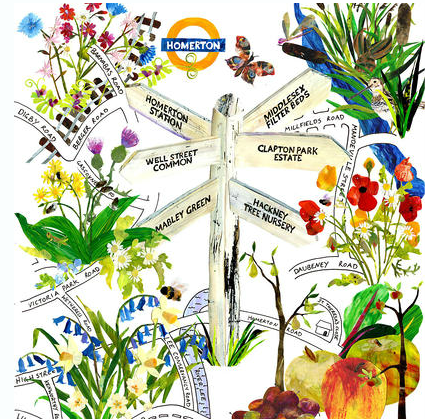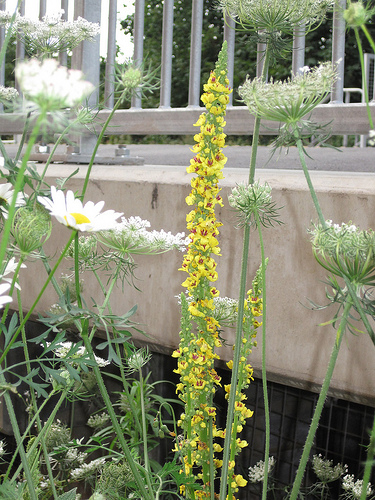Miss Thrifty0 March 12, 2012

I lived in Hackney, East London for years. Now I live in Yorkshire, in a tiny city sandwiched between the Moors and the Dales, and surrounded by woods and rolling hills and sheep. The two places are very different, of courses, and in my head my city living experiences are divided into the green (North Yorkshire) and the glass-fronted (London).
I think of London as glass-fronted rather than grey because it isn’t grey at all. There are beautiful parks, fields, gardens and squares agogo. Even my little home patch in East London, which has its scruffy and rundown parts, also has some tip-top green spaces if you know where to look.
So I was delighted to discover that a local community group called Friends of Homerton Station has been hard at work creating wildflower meadows around Homerton Station, to brighten the place up a bit.
As the group’s website notes:
We wanted to do something special to make Homerton a more beautiful place to live, and to change visitors’ first impressions. Around 360,000 passengers pass through Homerton Station each year, so creating a welcoming display of wildflowers could have a massive impact on how people feel about the area.
Here are some of the flowers planted by the group:
Snowdrops . . . bluebells . . . wild daffodils . . . ransoms . . . primroses . . . red campion . . . cowslips . . . cow parsley . . . greater stitchwort . . . salsify . . . meadow cranesbill . . . hedge bedstraw . . . ox-eye daisy . . . meadow buttercup . . . cornflower . . . foxglove . . . purple loosestrife . . . wild carrot . . . birds foot trefoil . . . lesser knapweed . . . meadowsweet . . . St Johns wort . . . corn marigold . . . corn poppy . . . fennel . . . selfheal . . . teasels . . . field scabious . . . nettle leaved bellflower . . . corn chamomile . . . corncockle . . . selfheal . . . meadow vetchling . . . reflex stonecrop . . . yellow toadflax . . . yarrow . . . rock rose . . . hedge garlic . . . fox and cubs . . . dark mullein . . . lady’s bedstraw . . . betony . . . red valerian . . . marjoram . . . germander speedwell . . . small scabious . . . evening primrose . . . rosebay willowherb . . . coltsfoot . . . musk mallow . . . tufted vetch . . . woad . . . white campion . . chicory . . vipers bugloss . . . ribwort plantain . . yellow rattle . . mignonette
And here are some of the results (from the Friends of Homerton Station’s Flickr account):
Not bad, eh?
This weekend, the group is leading a free Discover Nature walk in and around Homerton Station The event is billed as an exploration of local wildflower and food-growing projects. If you live nearby and are interested in taking part, the details are as follows:
The walk begins outside Homerton Station at 11 am on Saturday 17 March 2012. Walkers will be taken through Mabley Green wildflower meadow, biodiversity initiatives at Clapton Park Estate, along the River Lee towpath – and will finish at around 1 pm, with lunch provided at the Tree Nursery.
You can find further information here. The walk and lunch are both free, but places are limited so the organisers have asked people to book places in advance.
If you would like to join the walk, contact Sue at [email protected].
(P.S. The rather splendid poster was created by Erica, of Garden Pantry fame.)


0 Responses to “Homerton: London’s first wildflower station”